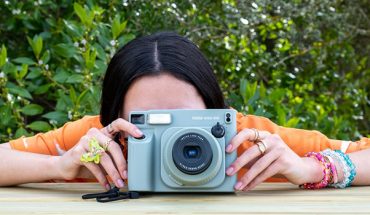By Lee Rickwood,
‘Go jump in the lake!’
Not every publisher’s assignment is so blunt, but what’s a correspondent to do when asked to review an underwater camcorder – hold your breath and dive right in?
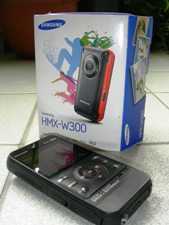
Samsung's HMX-W300 is now available in Canada.
Some will say the mini-camcorder market is dead, but a few models, like the new Samsung HMX-W300, have taken the concept one step further – or one dive deeper.
This point-and-shoot HD pocket video camera is sealed up tight; its sealed control pad, locked I/O doors and recessed mounts are rated as shock-resistant and dustproof, and waterproof to five meters, or about 16 feet.
If true, then is an ideal little camcorder for outdoor enthusiasts, family vacationers, backyard swimmers and other adventurers.
Now, it has been a warm spring so far, but Lake Ontario is freezing – among its many environmental challenges, so jumping in was out of the question on this assignment.
Even so, the W300 starts up fast and shoots quickly.
Even better, it is unique among many camcorders in that it has a record pause button – you can momentarily stop shooting, get another angle, position or frame, and continue the recording without creating another separate clip – tons of little clips can be a nuisance in editing, sharing or playback, so this feature is quite handy.
For me, the best opportunity to test this product – short of an assignment in Hawaii – was my friend’s basement, and his tropical fish aquarium!
The Samsung W300 Camera in action underwater!
Easy enough – the W300 isn’t much bigger than a smartphone, and of course it’s very lightweight.
On the backside, there’s a 2.3-inch 230K LCD, and just below that, the main control panel, featuring a circular touch pad and six small buttons (all embedded underneath a rubberized, waterproof surface).
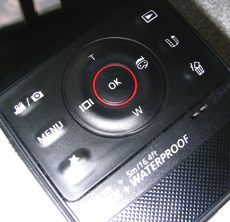
Simple, basic controls on the back of the W300.
The front face has the 29.6mm wide-angle fixed focal lens opening, and two very small and irregularly shaped holes (for keeping out sand and stuff) for the stereo mics.
On the unit’s edges, side or bottom, are small flip-open doors that cover a very short USB arm, a very small card slot for microSD memory cards slot and/or a very small micro-HDMI port.
These doors have small locks, part of the unit’s water and dust proofing, and must be securely closed and locked before immersion.
On the right side is a power button, and the camera goes from ‘Off’ to shooting video (on dry land or underwater) in just seconds.
If you are brave enough, that is. (I am old school, OK? Tossing any camera into the water runs against my religion, being raised on Bolex 16mm film cams that we treated like the gold they were.)
So, even just aquarium water intimidates me, but plucking up my courage, I turned the camera on, set it to Aqua mode, and – arrgghhh – shoved ‘er in!
* * *
My worst fears were immediately confirmed!
Pulling the camera back out, I saw it had crashed and frozen up – not Lake Ontario frozen, mind you, but stuck in record mode that would not disengage!
No surface controls did anything; not even the power button!
Luckily, there is a teeny little ‘Reset’ button under the micro card door, and simple paper clip repair was needed – and effective.
Has the manufacturer been through this before, I wondered?
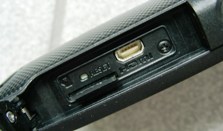
Card slots and I/O connections - and the Reset button - are hidden behind water tight doors.
The second test was much better; I have clips with nice footage from the floor of the aquarium – James Cameron, watch out! – that looks rich in colour, nicely bright in exposure, and even comes with that weird ‘underwater’ reverb sound.
* * *
Over all, video quality on the 300 is pretty good – if you are watching on a small computer screen.
It records a full 1,920 x 1,080/30p HD signal (and there is a 720p setting), but put the image up on a big screen or home HDTV, and the visual artifacts start to show through. Edges are a little rough, fast panning is kind of blurry, even simple handheld shooting shakes almost too noticeably in big screen viewing.
(The camera has an electronic image stabilization setting, which helps a bit, but not if there is lots of rapid or sudden movement. There’s also a 3x digital zoom, but it can degrade the image and drain the battery if used too much, like most such features.)
So once you have some footage recorded, the W300 begins to offer some more added features: it comes with embedded video editing and image manipulation software, called Intelli-studio, which has a really good set of editing tools, all told.
Clips can be trimmed, sorted and re-arranged; they can be combined with other audio sources; they can be changed with special effects; they can even be tagged, shared and posted to social networks like YouTube, Facebook and Twitter (the cameras asks for permission, once it is hooked up to a PC).
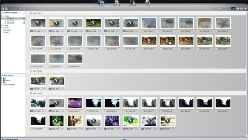
An embedded Intellistudio editing program is included with the mini-camcorder
You don’t even need to install the software on a computer; it can run directly from the device. To edit, you do need to transfer clips to a computer first, though – and to get any editing program updates, you need to install the program on a good, fast PC.)
Video is recorded in an MPEG-4 AVC/H.264 format, so other editing and manipulation programs can be used.
No computer is needed to use on-board camera features like My Clip – so you can tag video and highlight the best scenes for playback and sharing – and Smart Background Music 2.0, an upgrade that lets you sync video to music, with volume adjustments over or under a video clip.
The W300 comes in yellow/orange, red and black; the unit is available in a recommended accessories package with extra protective carrying cases, a mini record card and extension USB cable.
The W300 pocket camcorder (MSRP: $199.99 in Canada) is available now from authorized Samsung retailers.
-30-
submitted by Lee Rickwood

Some accessories and options available for the Samsung W300.

